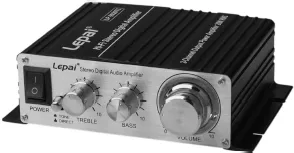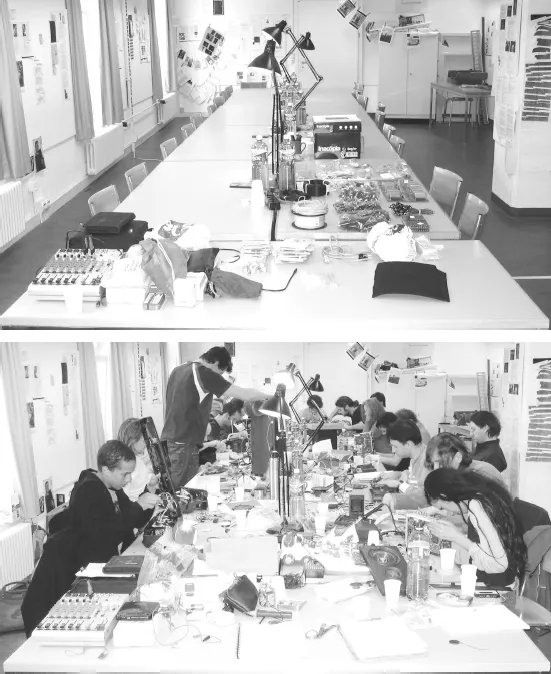
Handmade Electronic Music
The Art of Hardware Hacking
Nicolas Collins
- 434 pagine
- English
- ePUB (disponibile sull'app)
- Disponibile su iOS e Android
Handmade Electronic Music
The Art of Hardware Hacking
Nicolas Collins
Informazioni sul libro
Handmade Electronic Music: The Art of Hardware Hacking provides a long-needed, practical, and engaging introduction to the craft of making—as well as creatively cannibalizing—electronic circuits for artistic purposes. With a sense of adventure and no prior knowledge, the reader can subvert the intentions designed into devices such as radios and toys to discover a new sonic world. You will also learn how to make contact microphones, pickups for electromagnetic fields, oscillators, distortion boxes, mixers, and unusual signal processors cheaply and quickly. At a time when computers dominate music production, this book offers a rare glimpse into the core technology of early live electronic music, as well as more recent developments at the hands of emerging artists.
This revised and expanded third edition has been updated throughout to reflect recent developments in technology and DIY approaches. New to this edition are chapters contributed by a diverse group of practitioners, addressing the latest developments in technology and creative trends, as well as an extensive companion website that provides media examples, tutorials, and further reading. This edition features:
- Over 50 new hands-on projects.
- New chapters and features on topics including soft circuitry, video hacking, neural networks, radio transmitters, Arduino, Raspberry Pi, data hacking, printing your own circuit boards, and the international DIY community
- A new companion website at www.HandmadeElectronicMusic.com, containing video tutorials, video clips, audio tracks, resource files, and additional chapters with deeper dives into technical concepts and hardware hacking scenes around the world
With a hands-on, experimental spirit, Nicolas Collins demystifies the process of crafting your own instruments and enables musicians, composers, artists, and anyone interested in music technology to draw on the creative potential of hardware hacking.
Domande frequenti
Informazioni
PART 1
Starting
CHAPTER 1
Getting Started
Tools and Materials Needed
Listening

- A classic hi-fi stereo amplifier, like your parents used to own. It needn’t be very powerful (10–30 watts) or high quality. Look around the local thrift shops or flea markets or on eBay for a used one. It should have connections on the back for external speakers, rather than built-in speakers like the mini guitar amps.
 Figure 1.2A low-power amplifier kit: assembled circuit board (left) and mounted in an Altoids tin (right).
Figure 1.2A low-power amplifier kit: assembled circuit board (left) and mounted in an Altoids tin (right). - At the time of writing, there are a large number of small, inexpensive stereo amplifiers on the market. Employing the aforementioned class D technology, these amps are efficient enough to run off a small wall wart power supply. Find one with 10–30 watts per channel and make sure it has connections for external speakers (Figure 1.3).
- Alternatively, you can build your own amplifier using a slightly more powerful version of the amplifier kits described prior (Figure 1.4).


Tools
- A soldering iron, with a very fine point, 25–60 watts. Not a soldering gun or anything from the plumber’s section of the hardware store. Don’t get a cheap iron—it makes it very frustrating to learn soldering. Weller makes good ones that are reasonably priced and have replaceable, interchangeable tips.
- Solder—fine, rosin core—not “acid-core” solder, that’s also for plumbers.
- Diagonal cutters, small, for cutting wire and component leads down by the circuit board.
- Wire strippers (unless you have the perfect gap between your front teeth)—simple, adjustable manual kind for light-gauge wire.
- A set of jeweler’s screwdrivers (flat and Phillips)—for opening toys with tiny screws.
- A Swiss Army knife.
- A pair of scissors.
- A cheap digital multimeter, capable of reading resistance, voltage, and current.
 Figure 1.5Some handy tools.
Figure 1.5Some handy tools. - Plastic electrical tape.
- Mini jumper cables with small alligator clips at each end, at least 20 of them—you can never have too many.
- A Sharpie-style fine-tipped permanent marker.
- Some small spring clamps or clothespins.
- A small vise or “third hand” device for holding things while you solder them.
- Basic shop tools—such as a small saw for metal and plastic, files, and an electric drill—are useful when you start to work on packaging.
Parts
- Lightweight insulated hookup wire, 22–24 gauge, one roll stranded, one roll solid.
- Lightweight shielded audio hookup cable, single conductor plus shield.
- Assortment of standard value resistors, 1/8 or 1/4 watt. Sets are easily and inexpensively available from online retailers. If you want to make the minimum investment, the critical values we use are: 100 Ohm, 1 kOhm, 2.2 kOhm, 10 kOhm, 100 kOhm, and 1 mOhm.
- Assortment of capacitors, in the range of 10 pf to 0.1 uf monolithic ceramic or metal film, and 1 uf to 47 uf electrolytic. These can also be bought in sets, but since they are a little more expensive than resistors, you might prefer to purchase a handful of each of a few different values from across the full range and then replace or supplement them as needed. The most commonly used values in our projects are: 0.01 uf, 0.1 uf, 1.0 uf, 2.2 uf, 4.7 uf, and 10 uf.
- 9-volt battery clips—the things that snap onto the nipples at the end of a battery and terminate in lengths of wire. Get five or more.
- Assorted audio jacks and plugs to mate with other devices, such as the headphone jack on your phone or the input to your amplifier.
Batteries
Architecture
